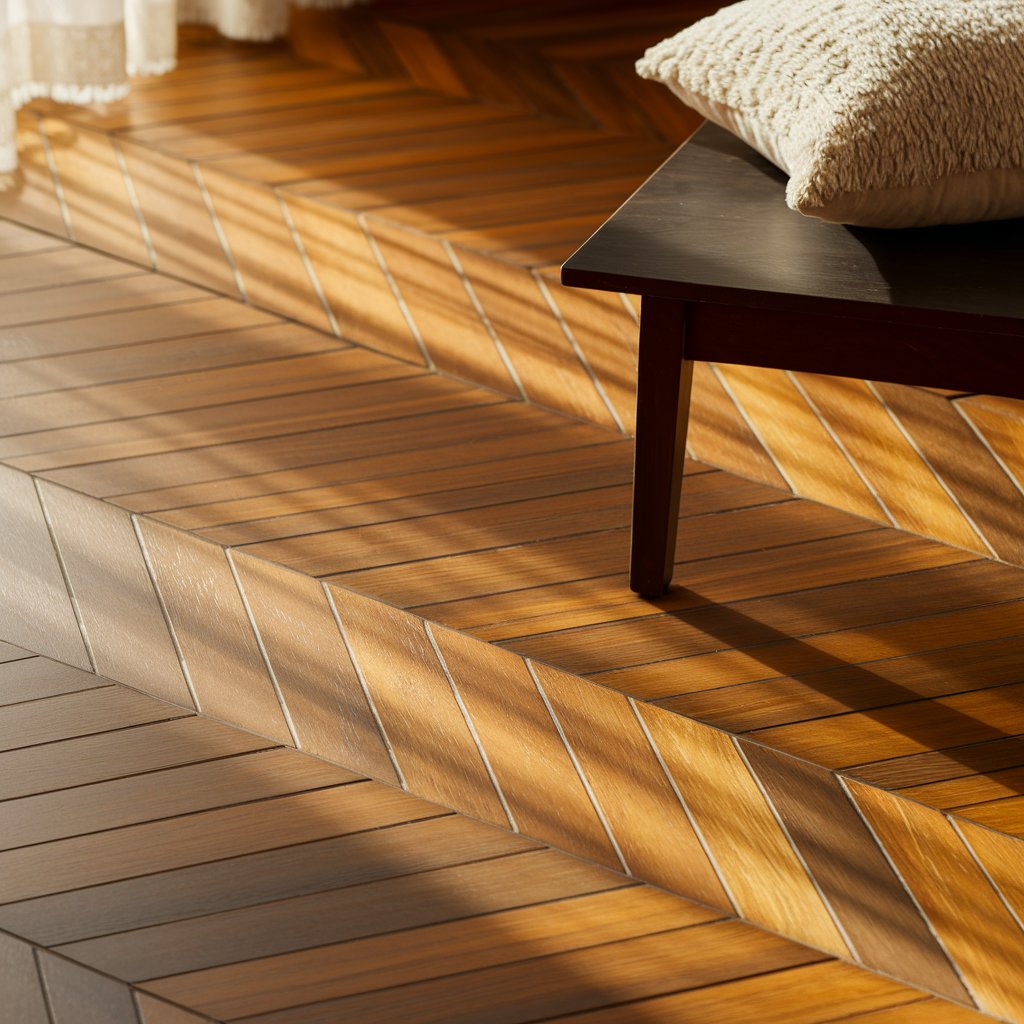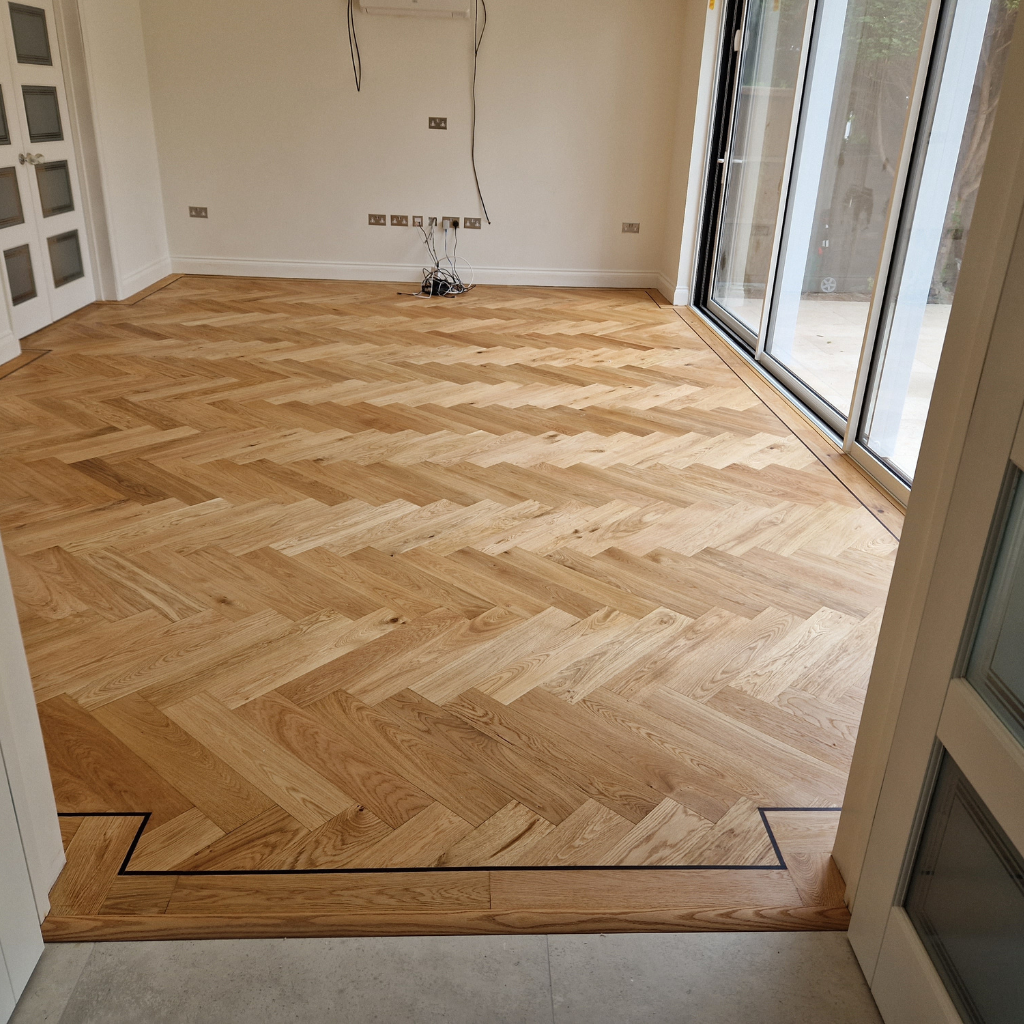Herringbone vinyl flooring brings a neat and timeless look to any space. People like it because the pattern can create a classic feel while demanding less upkeep than other flooring materials. This type of vinyl floor is also known for its sturdy durability and waterproof qualities. The design suits almost every room, from a cosy kitchen to a busy hallway. It comes in many styles, giving you lots of creative ideas. This guide will describe how herringbone flooring vinyl can balance beauty, performance, and budget-friendly benefits, all in one installation. It aims to help you decide if herringbone vinyl flooring is right for your home.
Herringbone patterns have long captured imaginations with their zigzag charm. Today, modern vinyl floors take this classic design to new heights. People choose herringbone for its ability to fit both cosy rooms and upscale interiors. In this section, you will learn about the long history of herringbone, as well as the reasons why vinyl fits so well with this pattern.
The herringbone design traces back to ancient roads and buildings. Early civilisations laid bricks or stones in this zigzag arrangement because it strengthened the structure. Over the centuries, the pattern grew popular in grand estates where owners wanted bold geometric floors that stood out. Its striking shape earned the name “herringbone” for its resemblance to the bones of a fish. Eventually, architects adopted it for parquet floors, using real wood to create a regal mood. In modern times, vinyl floor manufacturers captured that same sophisticated feel without the hassle of delicate upkeep. The innovation has made herringbone vinyl flooring an inviting choice for anyone looking to bring a sparkle of refinement to everyday life. While older materials demanded hours of waxing and careful polishing, vinyl floors blend shine with convenience. This fusion of heritage and practicality is why the herringbone pattern remains beloved.

Vinyl keeps pace with the elegance of herringbone wood flooring but at a friendlier cost. It’s well suited to high-traffic settings, thanks to its sturdy wear layers that handle daily footfalls without losing their sheen. Unlike traditional hardwood, vinyl rarely demands special polishes or protective treatments. A simple sweep or damp mop is enough to keep it looking fresh. Aside from ease of maintenance, many homeowners enjoy vinyl’s environmentally mindful elements, such as lower resource use during production. These floors also fit spaces where children or pets play, thanks to low emission levels and minimal care requirements. All these practical perks join forces with the timeless herringbone layout, proving that both form and function can coexist. Anyone who wants the textured pattern of real wood, minus the extra labour, can confidently turn to herringbone vinyl flooring.
Waterproof vinyl floors have changed the way we approach damp spaces like the kitchen. Their protective layers keep moisture from soaking in, reducing the risk of damage or discolouration. When combined with a herringbone style, these floors bring a showstopper design into an area prone to spills and messes. Let’s go further into these beneficial traits.
Modern vinyl boards feature solid cores and sealants that repel water. This means a spilled glass of juice or an accidental splash from the sink won’t seep into the floor. In rooms such as your kitchen, avoiding water penetration is vital for longevity. Waterproof vinyl works better than many alternatives because it resists swelling or warping. It is also popular in bathroom floors where puddles are common.
Along with keeping moisture at bay, these floors often come in slip-resistant finishes that can help when surfaces are wet. Households find that cleaning up moisture on vinyl is swift: a soft cloth or a sponge can handle most mishaps. Over time, protecting against water damage translates into fewer replacements or repairs, adding an extra advantage for busy networks of cooking, cleaning, and family gatherings.
A significant appeal of herringbone vinyl flooring is that it can mirror the charm of real wood without the usual upkeep or cost. Advanced printing techniques replicate the grain, knots, and variations found in hardwood, resulting in floors that look strikingly similar to oak or walnut. Yet vinyl planks maintain a lighter feel underfoot, combining warmth with scratch resistance. Homeowners appreciate not having to refinish or protect their floors from everyday bumps. This makes vinyl a more straightforward solution for kids’ rooms or high-traffic areas. The herringbone arrangement accentuates wood-like textures by showing subtle colour shifts along each board. As a waterproof surface, it’s a perfect partner for rooms where moisture might be a worry, but you still desire the depth and style real wood can bring.
Many people ask, “Can you herringbone vinyl flooring on your own?” The answer is yes, if you follow clear guidelines and use the correct tools. Preparation is crucial, and you should understand how to lay herringbone vinyl flooring for the best outcome. This section will share the basics, along with some expert tips.

Before laying herringbone vinyl flooring, it’s best to check that the subfloor is flat, dry, and free from dust. If you’re using a click-lock system, panels often snap together without much fuss. Dry-fit a few pieces to see where the pattern aligns, adjusting if needed. Measure the midpoints of the room to create a guideline for the centre of the design. This approach helps the pattern flow neatly from one end to the other. Some herringbone flooring vinyl products require adhesive, so a careful application of glue might be necessary. Follow the manufacturer’s instructions on spacing or expansion gaps, since vinyl can slightly shift over time. If you prefer a more hands-off method, hiring a professional to manage to install of herringbone vinyl flooring can save you a lot of effort. Either way, planning the layout is key. Rushing tends to leave you with crooked rows and wasted materials.
Start by thinking, “How to lay herringbone vinyl flooring with minimal errors?” Patience is your friend. Map out where each plank goes before sticking anything down. Keep an eye on transitions at doorways, especially if you’re moving between different types of floor surfaces. You might need special trim pieces for smooth bridging. An added step that can make all the difference is letting the vinyl planks acclimatise to the room’s temperature. Set them out flat for at least a day. This reduces any chance of warping or buckling after installation. Also, always use a sharp utility knife or a proper saw for neat cuts. If you find yourself stuck, consider calling a flooring pro to ensure your herringbone vinyl floor ends up stunning and feels secure. Laying herringbone vinyl flooring well often preserves the pattern’s crisp angles and keeps the floor snug.
Designing a space with herringbone vinyl flooring can feel inspiring. You can choose from neutral shades for a soft ambience or go bold with darker tones for drama. The range of colour and style choices is vast. Below, we’ll discuss trending colour palettes and ways you can mix classic elegance with contemporary flair.
People accustomed to gentle beiges or warm greys often explore herringbone designs in vinyl to add dimension. Lighter shades can open up a smaller area, making it feel bright and airy. Darker hues provide a rich, sophisticated setting. Herringbone also looks engaging in multi-tonal or blended planks where neighbouring boards carry subtle contrasts. This visually elongates a room and draws the eye down the zigzag pattern. When selecting a colour, consider the furniture, wall paint, and general décor style. Lighter floors might pair well with minimalistic or Scandinavian interiors, while darker floors can anchor a modern, industrial layout. To see how colours come together, many brands offer samples. Testing them under your lighting helps confirm the perfect match.

Traditional herringbone patterns tend to feature narrower planks for a refined, timeless appeal. If you crave more impact, thicker boards can modernise the look while still nodding to a classic foundation. Some homeowners enjoy double herringbone, which involves parallel pairs of planks to create a bolder design. Others experiment by placing the pattern diagonally across the room for an unexpected twist. Mixing a herringbone vinyl floor with a coordinating border or different layout can define distinct zones. If you're planning to lay vinyl flooring, for instance, you could install herringbone in the living area, then switch to straight boards in the hallway, separated by a neat transition strip. A simple table comparing plank widths or pattern orientation might help you plan your dream floor.
| Pattern Type | Plank Width | Visual Impact |
|---|---|---|
| Single Herringbone | Narrow (< 5 inches) | Traditional Charm |
| Double Herringbone | Wider (> 5 inches) | Striking Modern Twist |
Ultimately, each arrangement has its personality, so blend them to discover the right fit for your home.
Herringbone vinyl flooring stands out as a winning combination of classic design and modern practicality. It pairs waterproof features with easy maintenance, making it handy in kitchens, entryways, or any place that demands durability. Whether you fancy darker tones for a moody vibe or lighter colours for an airy feel, herringbone vinyl floors can match your style. By following the proper steps for installation, you can enjoy a floor that looks refined for many years. If you’re unsure about measuring, cutting, or aligning the zigzag pattern, there’s always a professional ready to help. Explore the warmth, texture, and timelessness of herringbone vinyl today.